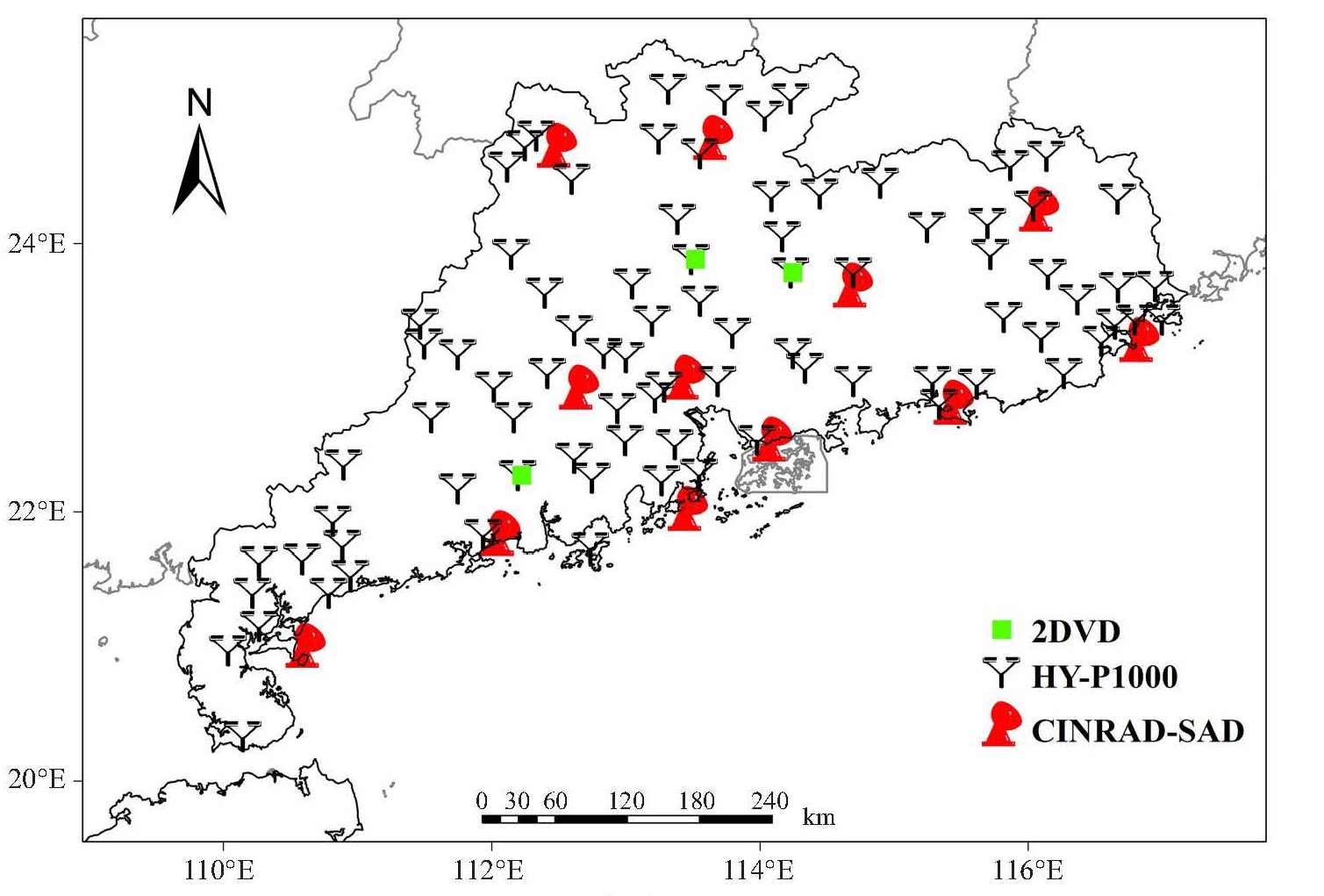Advancements in 0-6 Hour Blended Quantitative Precipitation Forecasting Technique for South China
-
摘要: 为进一步提升0~6 h定量降水预报(Quantitative Precipitation Forecast,QPF)精度,首先对CMA-GD (R3)和CMA-GD(R1)逐时降水进行相位和强度订正,并基于自适应融合方程实现融合;其次,对双偏振雷达水平反射率因子(ZH)和差分传播相移率(KDP)两个参数进行外推,在基于多年雨滴谱资料对广东降水进行时空划分并分别拟合降水反演关系式的基础上实现降水反演;最后,基于动态权重融合技术实现双偏振雷达外推预报和模式预报的融合,并对影响预报精度的不同模式融合方案和基于不同高度CAPPI参数外推方案两个关键因素进行分析。结果表明:(1) 弱降水时(雨强 < 5 mm·h-1),三种融合方案产品各区域和预报时次各有优劣,当雨强≥ 5 mm·h-1时,双偏振雷达外推与两个模式融合产品(QPF_Blending)较单模式融合(QPF_R1和QPF_R3)的最优评分至少提升15%以上,且雨强越大,提升越明显;(2) 内陆地区(距离海岸线130 km以外的区域)使用高度过低或过高的CAPPI会对第1 h QPF精度产生明显影响,但总的来说使用3 km高度的CAPPI外推预报的QPF精度最高;(3) 改进后的0~6 h QPF产品在各预报时效和降水量级上ETS或TS评分都明显提升,雨强≥1 mm·h-1时TS评分提升率达20.4%,随着雨强增大,提升率也越大。研究成果有效支撑了华南0~6 h强降水预报预警业务,对防灾减灾有重要意义。Abstract: To further improve the accuracy of 0-6 quantitative precipitation forecast (QPF), this study applied phase and intensity corrections to hourly precipitation data from the CMA-GD (R3) model and the CMA-GD (R1) model, followed by blending achieved based on an adaptive blending equation. Secondly, extrapolation was performed on two dual-polarization radar parameters: horizontal reflectivity (ZH) and specific differential propagation phase shift (KDP). Based on the spatiotemporal classification of precipitation in Guangdong using multi-year disdrometer data and the fitting of precipitation retrieval relationships, precipitation retrieval was realized. Finally, dynamic weighting blending technique was used to blend dual-polarization radar extrapolation with model forecasts. Key factors affecting forecast accuracy, such as different model blending schemes and extrapolation schemes based on different constant-altitude plan-position-indicator (CAPPI) parameters at varying heights, were analyzed. The results show that: (1) For weak precipitation (rainfall intensity < 5 mm · h-1), the three model blending schemes exhibited varying performance across different regions and forecast times. However, for rainfall intensities ≥ 5 mm · h-1, the dual-polarization radar extrapolation combined with two model blending products (QPF_Blending) outperformed single-model blending products (QPF_R1 and QPF_R3) by at least 15%, with greater improvements observed for higher rainfall intensities. (2) In inland areas (beyond 130 km from the coastline), the use of CAPPI parameters at excessively low or high altitudes significantly impacted the accuracy of 1-hour QPF. Overall, CAPPI extrapolation at a height of 3 km yielded the highest QPF accuracy. (3) The improved 0-6 hour QPF products showed significant improvements in equitable threat score or threat score (TS) at various forecast lead times and precipitation levels, with a TS score improvement rate of 20.4% when the rainfall intensity was higher than 1 mm · h-1, and the improvement rate increased with increasing rainfall intensity. These findings effectively support the operational forecasting and warning of heavy rainfall within 0-6 hours in South China, which is of great significance for disaster prevention and mitigation.
-
表 1 CMA-GD(R3)和CMA-GD(R1)
模式类型 CMA-GD(R3) CMA-GD(R1) 预报范围 96.60~122.76 °E,16.60~30.76 °N 107.2~118.8 °E,18.2~26.8 °N 预报时效 30 h 6 h 预报时次 逐时更新 逐12 min更新 空间分辨率 0.03 ° × 0.03 ° 0.01 ° × 0.01 ° 时间分辨率 1 h 12 min 表 2 QPF_R3、QPF_R1和QPF_Blending的0~6 h预报时效的平均评分
评分标准 QPF 量级/(mm·h-1) ≥0.1 ≥1 ≥5 ≥10 ≥20 ≥25 ≥30 ≥50 TS QPF_R3 0.471 0.341 0.127 0.079 0.048 0.038 0.033 0.008 QPF_R1 0.455 0.338 0.131 0.083 0.049 0.038 0.033 0.008 QPF_Blending 0.369 0.289 0.137 0.102 0.079 0.067 0.055 0.027 FAR QPF_R3 0.269 0.509 0.820 0.892 0.934 0.949 0.957 0.991 QPF_R1 0.265 0.491 0.810 0.884 0.932 0.949 0.957 0.991 QPF_Blending 0.412 0.583 0.800 0.847 0.871 0.890 0.908 0.956 PO QPF_R3 0.431 0.472 0.695 0.769 0.850 0.869 0.876 0.951 QPF_R1 0.456 0.498 0.702 0.771 0.850 0.869 0.876 0.951 QPF_Blending 0.502 0.516 0.696 0.763 0.831 0.856 0.880 0.936 Bias QPF_R3 0.779 1.075 1.695 2.143 2.281 2.598 2.879 5.265 QPF_R1 0.740 0.988 1.564 1.983 2.217 2.566 2.872 5.255 QPF_Blending 0.847 1.162 1.518 1.554 1.306 1.304 1.309 1.455 表 3 QPF_1.5、QPF_2.0、QPF_2.5和QPF_3.0的0~6 h预报时效的平均评分
评分标准 QPF 量级/(mm·h-1) ≥0.1 ≥1 ≥5 ≥10 ≥20 ≥25 ≥30 ≥50 TS QPF_1.5 0.352 0.245 0.126 0.092 0.066 0.055 0.047 0.024 QPF_2.0 0.356 0.249 0.126 0.092 0.068 0.056 0.047 0.023 QPF_2.5 0.353 0.246 0.125 0.092 0.068 0.057 0.048 0.023 QPF_3.0 0.369 0.289 0.137 0.102 0.079 0.067 0.055 0.027 FAR QPF_1.5 0.493 0.655 0.813 0.859 0.892 0.910 0.922 0.962 QPF_2.0 0.490 0.653 0.813 0.858 0.888 0.907 0.920 0.962 QPF_2.5 0.491 0.655 0.814 0.857 0.886 0.902 0.918 0.960 QPF_3.0 0.412 0.583 0.800 0.847 0.871 0.890 0.908 0.956 PO QPF_1.5 0.465 0.544 0.724 0.794 0.856 0.878 0.894 0.940 QPF_2.0 0.460 0.533 0.719 0.792 0.854 0.878 0.896 0.945 QPF_2.5 0.466 0.539 0.725 0.795 0.857 0.878 0.898 0.948 QPF_3.0 0.502 0.516 0.696 0.763 0.831 0.856 0.880 0.936 Bias QPF_1.5 1.055 1.322 1.474 1.458 1.332 1.350 1.359 1.580 QPF_2.0 1.061 1.344 1.500 1.462 1.299 1.311 1.300 1.449 QPF_2.5 1.049 1.335 1.482 1.436 1.250 1.248 1.245 1.294 QPF_3.0 0.847 1.162 1.518 1.554 1.306 1.304 1.309 1.455 表 4 QPF_OLD和QPF_Blending的0~6 h预报时效的平均评分
评分标准 QPF 量级/(mm·h-1) ≥0.1 ≥1 ≥5 ≥10 ≥20 ≥25 ≥30 ≥50 TS QPF_OLD 0.350 0.24 0.124 0.089 0.044 0.025 0.014 0.000 QPF_Blending 0.369 0.289 0.137 0.102 0.079 0.067 0.055 0.027 FAR QPF_OLD 0.523 0.676 0.806 0.816 0.784 0.792 0.792 1.000 QPF_Blending 0.412 0.583 0.800 0.847 0.871 0.890 0.908 0.956 PO QPF_OLD 0.433 0.518 0.744 0.854 0.948 0.973 0.985 1.000 QPF_Blending 0.502 0.516 0.696 0.763 0.831 0.856 0.880 0.936 Bias QPF_OLD 1.191 1.488 1.323 0.795 0.242 0.131 0.071 0.001 QPF_Blending 0.847 1.162 1.518 1.554 1.306 1.304 1.309 1.455 -
[1] ZHANG S, LIANG Z, WANG D, et al. Nocturnal convection initiation over Inland South China during a record-breaking heavy rainfall event[J]. Mon Wea Rev, 2022, 150(11): 2 935-2 957. [2] 韦志刚, 李娴茹, 刘雨佳, 等. 1961-2018年华南年和各季极端降水变化特征的比较分析[J]. 高原气象, 2021, 40(6): 1 513-1 530. [3] 张亚萍, 程明虎, 夏文梅, 等. 天气雷达回波运动场估测及在降水临近预报中的应用[J]. 气象学报, 2006, 84(5): 631-646. [4] 王改利, 刘黎平, 阮征. 多普勒雷达资料在暴雨临近预报中的应用[J]. 应用气象学报, 2007, 18(3): 388-395. [5] 王改利, 赵翠光, 刘黎平, 等. 雷达回波外推预报的误差分析[J]. 高原气象, 2013, 32(3): 874-883. [6] 邹德龙, 冯业荣, 梁巧倩, 等. 0~3小时短时定量降水预报算法研究[J]. 热带气象学报, 2014, 30(2): 249-260. [7] 毕宝贵, 代刊, 王毅, 等. 定量降水预报技术进展[J]. 应用气象学报, 2016, 27(5): 534-549. [8] 袁凯, 李武阶, 李明, 等. 四种机器深度学习算法对武汉地区雷达回波临近预报的检验和评估[J]. 气象, 2022, 48(4): 428-441. [9] AYZEL G, HEISTERMANN M, WINTERRATH T. Optical flow models as an open Benchmark for radar-Based precipitation nowcasting (Rainymotion v0.1)[J]. Geosci Model Dev, 2019, 12(4): 1 387-1 402. [10] 陈元昭, 林良勋, 王蕊, 等. 基于生成对抗网络Gan的人工智能临近预报方法研究[J]. 大气科学学报, 2019, 42(2): 311-320. [11] 郭瀚阳, 陈明轩, 韩雷, 等. 基于深度学习的强对流高分辨率临近预报试验[J]. 气象学报, 2019, 77(4): 715-727. [12] 俞小鼎, 周小刚, 王秀明. 雷暴与强对流临近天气预报技术进展[J]. 气象学报, 2012, 70(3): 311-337. [13] CHEN Z T, DAI G F, WU K X, et al. Development of 1km-scale operational model in South China[J]. J Trop Meteor, 2021, 27(4): 319-329. [14] BROWNING K A. Review lecture: local weather forecasting[J]. Proceedings of the Royal Society A Mathematical Physical & Engineering Sciences, 1980, 371 (1 745): 179-211. [15] 程丛兰, 陈明轩, 王建捷, 等. 基于雷达外推临近预报和中尺度数值预报融合技术的短时定量降水预报试验[J]. 气象学报, 2013, 71(3): 397-415. [16] WARDAH T, AMINUDDIN A, RAMLI S, et al. Quantitative precipitation forecast using numerical weather prediction and meteorological satellite for kelantan and Klang River Basins[J]. Jurnal Teknologi, 2016, 79(1): 45-53. [17] 孙泓川, 吴海英, 曾明剑, 等. 结合中尺度模式物理约束的雷达回波临近外推预报方法研究[J]. 气象学报, 2022, 80(2): 257-268. [18] 谌芸, 曹勇, 孙健, 等. 中央气象台精细化网格降水预报技术的发展和思考[J]. 气象, 2021, 47(6): 655-670. [19] 程丛兰, 陈敏, 陈明轩, 等. 临近预报的两种高时空分辨率定量降水预报融合算法的对比试验[J]. 气象学报, 2019, 77(4): 701-714. [20] QIAOQIAN L, YERONG F, WENJIAN D, et al. A composite approach of radar echo extrapolation based on trec vectors in combination with model-predicted winds[J]. Adv Atmos Sci, 2010, 27(5): 1 119-1 130. [21] 陈超, 刘黎平, 王改利. 人工影响天气中雷达回波跟踪方法及其应用[J]. 气象科技, 2012, 40(3): 489-496. [22] 曹春燕, 陈元昭, 刘东华, 等. 光流法及其在临近预报中的应用[J]. 气象学报, 2015, 73(3): 471-480. [23] 汪瑛, 胡胜, 涂静, 等. 2016—2020年广东省定量降水预报检验评估[J]. 热带气象学报, 2021, 37(2): 154-165. [24] 刘段灵, 陈超. 最优TS评分方法在逐时降水订正中的初步应用及评估[J]. 热带气象学报, 2022, 38(4): 611-620. [25] 朱鹏程, 王东海, 曾智琳, 等. 粤港澳大湾区汛期降水的多模式集成预报方法的评估检验[J]. 热带气象学报, 2024, 40(2): 258-271. [26] 胡胜, 罗兵, 黄晓梅, 等. 临近预报系统(Swift)中风暴产品的设计及应用[J]. 气象, 2010, 36(1): 54-58. [27] 汪瑛, 冯业荣, 蔡锦辉, 等. 雷达定量降水动态分级Z-I关系估算方法[J]. 热带气象学报, 2011, 27(4): 601-608. [28] 黄丽萍, 陈德辉, 邓莲堂, 等. Grapes_Mesov4.0主要技术改进和预报效果检验[J]. 应用气象学报, 2017, 28(1): 25-37. [29] 陈子通, 徐道生, 戴光丰, 等. 热带高分辨率模式(Trams-V3.0)技术方案及其系统预报性能[J]. 热带气象学报, 2020, 36(4): 444-454. [30] 陈超, 胡志群, 胡胜, 等. Cinrad-Sa双偏振雷达资料在降水估测中的应用初探[J]. 气象, 2019, 45(1): 113-125. [31] CHEN C, LIU L P, HU S, et al. Operational evaluation of the quantitative precipitation estimation by a Cinrad-Sa dual polarization radar system[J]. J Trop Meteor, 2020, 26(2): 176-187 [32] 肖艳姣, 刘黎平. 新一代天气雷达网资料的三维格点化及拼图方法研究[J]. 气象学报, 2006, 64(5): 647-657. [33] BRANDES E A, ZHANG G, VIVEKANANDAN J. Experiments in rainfall estimation with a polarimetric radar in a subtropical environment[J]. J Appli Meteor, 2002, 41(6): 674-685. [34] 陈超, 刘黎平, 罗聪, 等. 两种雨滴谱仪观测对比及对雷达降水估测精度影响研究[J]. 气象, 2023, 49(10): 1 157-1 170. [35] 刘英, 柳崇健, 徐辉, 等. 藉物理耗散技术改进强降水数值模拟的初步研究[J]. 高原气象, 2006, 25(4): 651-657. [36] 胡广书. 数字信号处理导论[M]. 北京: 清华大学出版社, 2005. [37] 吴启树, 韩美, 刘铭, 等. 基于评分最优化的模式降水预报订正算法对比[J]. 应用气象学报, 2017, 28(3): 306-317. [38] ZHI X, QI H, BAI Y, et al. A comparison of three kinds of multimodel ensemble forecast techniques based on the tigge data[J]. Acta Meteorologica Sinica, 2012, 26(1): 41-51. [39] ZHANG H, ZHI X, JING C, et al. Study of the modification of multi-model ensemble schemes for tropical cyclone forecasts[J]. J Trop Meteor, 2015, 21(4): 389-399. [40] WANG Y, DAI K, ZONG Z, et al. Quantitative precipitation forecasting using multi-model blending with supplemental grid points: Experiments and prospects in China[J]. J Meteor Res, 2021, 35(3): 521-536. [41] RYZHKOV A V, GIANGRANDE S E, SCHUUR T J. Rainfall estimation with a polarimetric prototype of WSR-88d[J]. J Appli Meteor, 2005, 44(4): 502-515. [42] GIANGRANDE S E, RYZHKOV A V. Estimation of rainfall based on the results of polarimetric ECHO classification[J]. J Appl Meteor Climatol, 2008, 47(9): 2 445-2 462. [43] CIFELLI R, CHANDRASEKAR V, LIM S, et al. A new dual-polarization radar rainfall algorithm: Application in colorado precipitation events[J]. J Atmos Oceanic Technol, 2011, 28(3): 352-364. [44] CHEN G, ZHAO K, LU Y, et al. Variability of microphysical characteristics in the"21 · 7"henan extremely heavy rainfall event[J]. Sci China Earth Sci, 2022, (52): 1-18. [45] 黄兴友, 印佳楠, 马雷, 等. 南京地区雨滴谱参数的详细统计分析及其在天气雷达探测中的应用[J]. 大气科学, 2019, 43(3): 691- 704. [46] ULBRICH C W. Natural variations in the analytical form of the raindrop size distribution[J]. J Climate Appli Meteor, 1983, 22(10): 1 764- 1 775. [47] CHEN C, ZHANG A S, WU N G, et al. Statistical characteristics of raindrop size distribution in the South China Monsoon Region (Guangdong Province)[J]. J Trop Meteor, 2023, 29(1): 55-67. [48] ZHANG A, CHEN C, WU L. Regional variability of raindrop size distribution from a network of disdrometers over complex terrain in Southern China[J]. Remote Sensing, 2023, 15(10): 2 678. [49] CHEN G X, LAN R Y, ZENG W X, et al. Diurnal variations of rainfall in surface and satellite observations at the Monsoon Coast (South China)[J]. J Climate, 2018, 31(5): 1 703-1 724. [50] 李俊, 杜钧, 陈超君. 降水偏差订正的频率(或面积)匹配方法介绍和分析[J]. 气象, 2014, 45(5): 580-588. [51] LIU Y, XI D G, LI Z L, et al. A new methodology for pixel-quantitative precipitation nowcasting using a pyramid lucas Kanade optical flow approach[J]. J Hydrol, 2015, 529: 354-364. [52] BRUHN A, WEICKERT J, FEDDERN C, et al. Real-time optic flow computation with variational methods[C]//proceedings of the computer analysis of images and patterns. Berlin: Springer, 2003. [53] WU C, LIU L, CHEN C, et al. Challenges of the polarimetric update on operational radars in China—ground clutter contamination of weather radar observations[J]. Remote Sensing, 2021, 13(2): 217. [54] JORDAN P, SEED A, AUSTIN G. Sampling errors in radar estimates of rainfall[J]. J Geophys Res Atmos, 2000, 105(D2): 2 247-2 257. -






 下载:
下载:








 粤公网安备 4401069904700003号
粤公网安备 4401069904700003号